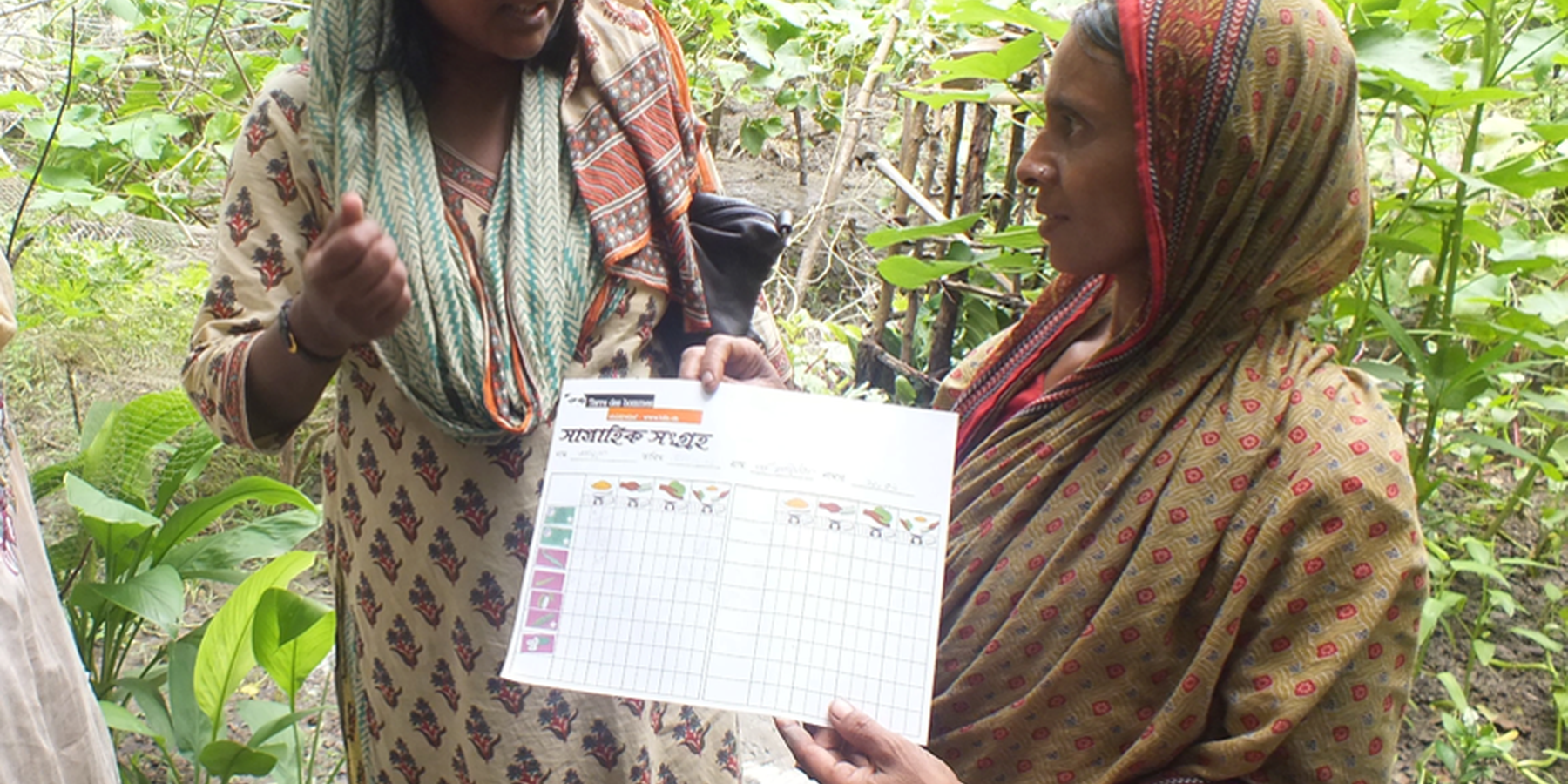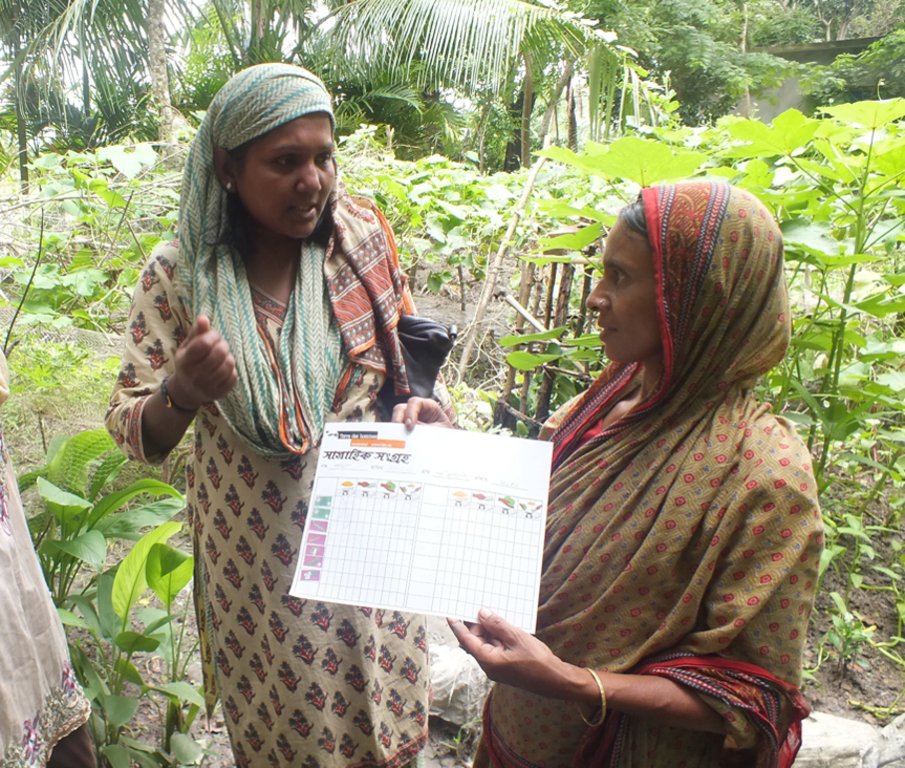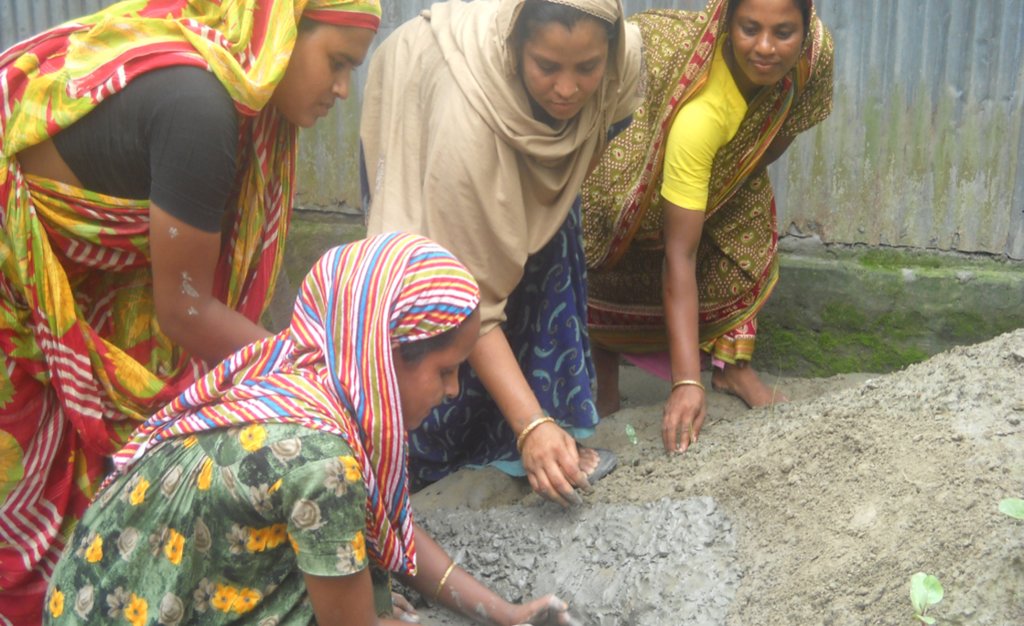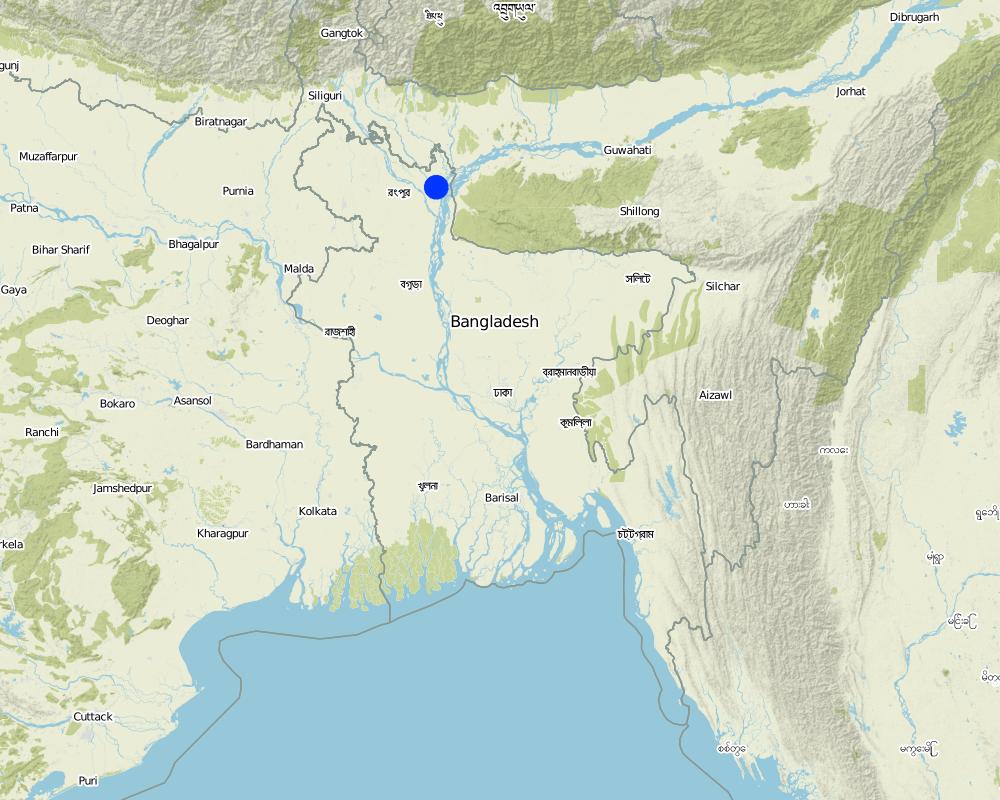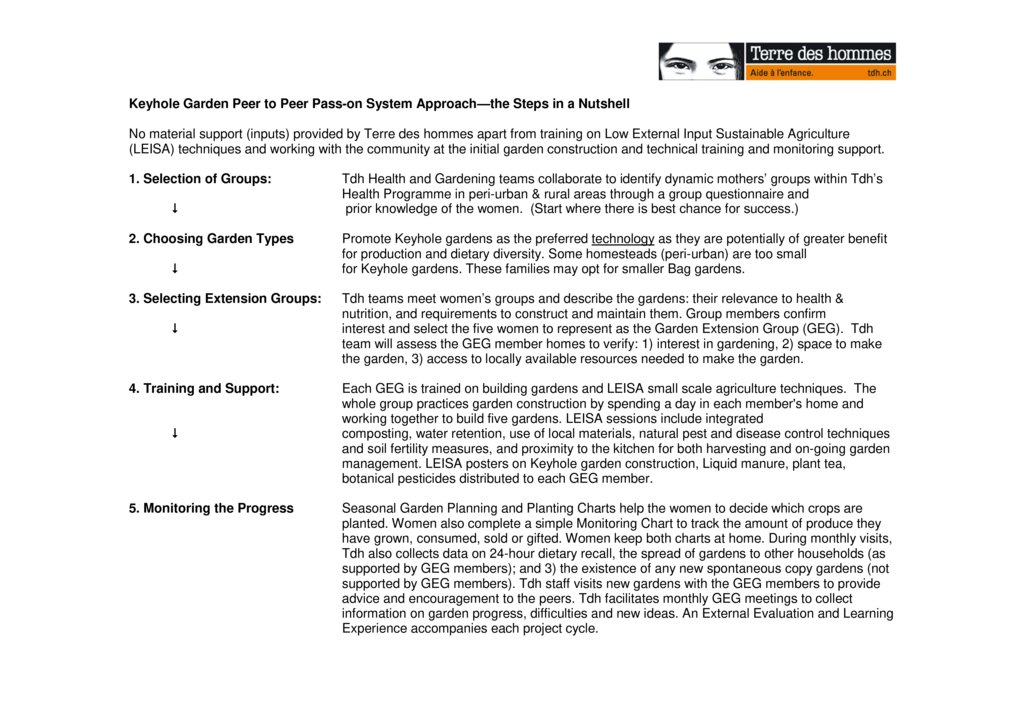Peer to Peer Pass-on Approach with Women [Бангладеш]
- Создание:
- Обновить:
- Составитель: John Brogan
- Редактор: Shahid Kamal
- Рецензенты: Alexandra Gavilano, Boris Orlowsky
approaches_784 - Бангладеш
Просмотреть разделы
Развернуть все Свернуть все1. Общая информация
1.2 Контактные данные специалистов и организаций, участвующих в описании и оценке Подхода
Ответственный (-ые) специалист (-ы)
Специалист по УЗП:
Brogan John
john.brogan@tdh.ch
Terre des hommes
15 Avenue Montchoisi 1006 Lausanne
Швейцария
WASH/DRR Advisor:
Специалист по УЗП:
Taylor Sheila
Sheila.Taylor@sendacow.org
Send a Cow UK
Название проекта, содействовавшего документированию/оценке Подхода (если применимо)
Book project: where people and their land are safer - A Compendium of Good Practices in Disaster Risk Reduction (DRR) (where people and their land are safer)Название организации (-ий), содействовавших документированию/оценке Подхода (если применимо)
Terre des Hommes (Terre des Hommes) - Швейцария1.3 Условия, регламентирующие использование собранных ВОКАТ данных
Когда были собраны данные (на местах)?
14/08/2013
Составитель и ответственный/-ые специалист(-ы) согласны с условиями, регламентирующими использование собранных ВОКАТ данных:
Да
1.4 Ссылка (-и) на Анкету (-ы) по Технологиям УЗП
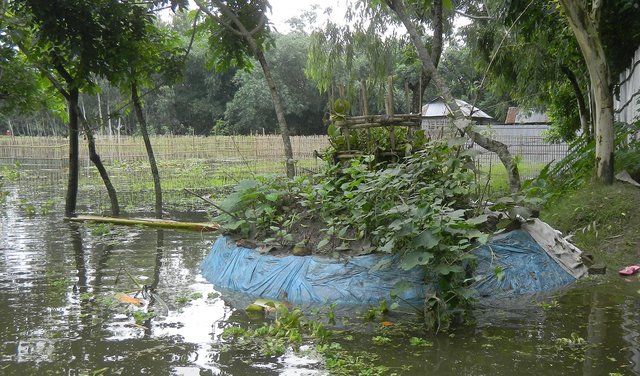
Keyhole Garden [Бангладеш]
The Keyhole Garden model of homestead vegetable cultivation enhances the resilience of families living in areas with climate-related hazards, such as flooding and drought. Keyhole gardens have been shown to increase vegetable production in all seasons, thereby improving household food autonomy and dietary diversity.
- Составитель: John Brogan
2. Описание Подхода УЗП
2.1 Краткое описание Подхода
Terre des hommes and Greendots introduced the Peer to Peer pass-on system to enable women's groups in Bangladesh to spread the Keyhole Garden technique within their communities with the aim of enabling year-round homestead vegetable production despite the risk of flooding and tidal surge.
2.2 Подробное описание Подхода
Подробное описание Подхода:
Keyhole Gardens, a type of small, productive homestead vegetable garden based on Low External Input Sustainable Agriculture (LEISA) techniques, have been used in various African countries for over 15 years and shown to increase the availability of food and dietary diversity (FAO). They were developed by gardeners and small-scale farmers (with the support of Send a Cow UK) to suit different situations, such as the cold, dry winters of Lesotho, the small backyards of Rwanda, and the humid heat of central Uganda. To improve year-round homestead nutritional self-sufficiency for vulnerable families in South Asia (where rates of acute malnutrition in young children regularly cross emergency thresholds), Keyhole gardens were adapted by Terre des hommes (Tdh) and Greendots to the conditions of river basin and coastal areas of Bangladesh (and eventually to India's Sundarbuns) . As a component to Tdh's maternal neonatal and child health (MNCH) programme, the technology is intended to support year-round homestead gardening despite weather extremes (flooding, tidal surge, cyclones).
To promote spontaneous replication of the Keyhole gardening in the local communities, the programme initiated a Peer to Peer Pass-on system within 40 mothers' groups (having a total membership of nearly 800 women). Each mothers' group selected five representatives (200 women) to form a Garden Extension Group (GEG) and participate in the first round of training with the understanding that they would share knowledge with other women in the MNCH programme and the surrounding community. The project team trained each GEG on building gardens and LEISA small scale agriculture techniques (including integrated composting, water retention, use of local materials, natural pest and disease control techniques and soil fertility measures, proximity to the kitchen for optimal management and harvesting). GEG group members practiced garden construction by working together to build gardens at the homes of all five members. All 200 initial gardens were monitored by Tdh extension workers on a weekly basis. Tdh verified output, use and the capacity of gardens to withstand monsoon conditions, and the extent of the of the Peer to Peer Pass-on experience.
See the Chart in Section 3.3 for more information.
2.3 Фотографии, иллюстрирующие Подход
2.4 Видеоматериалы по применению Подхода
Комментарий, краткое описание:
https://www.youtube.com/watch?v=WmDgGa0XIO8
BBC Media Action Bangladesh produced a segment on its "Amrai Pari" programme for the Bangladeshi public (in Bangla language) describing women's use and promotion of the Keyhole Garden technique in coastal communities on the Bay of Bengal.
Дата:
09/11/2014
Место:
Barguna District, Barisal Division, Bangladesh
Автор съемки:
BBC Media Action
2.5 Страна/ регион/ место, где применялся Подход
Страна:
Бангладеш
Административная единица (Район/Область):
Kurigram District / Rajshahi Division and Barguna District / Barisal Division
Более точная привязка места:
Kurigram municipality (Kurigram District), Patharghata Union (Barguna District)
Map
×2.6 Даты начала и окончания реализации Подхода
Год начала реализации:
2012
2.7 Тип Подхода
- в рамках проекта/ программы
2.8 Каковы цели/ задачи Подхода
The main aims of the approach are to involve women by building their capacity and peer network to replicate the Keyhole gardening approach within their communities.
The main objective of the approach is that that families, led by women 1) garden year-round with LEISA techniques, 2) increase the quantity and diversity of their homestead vegetable production and 3) verify that the DRR garden design reduces the consequences of flooding and tidal surge.
2.9 Условия содействующие применению Технологии/ Технологий в рамках Подхода или затрудняющие его
Социальные/ культурные/ религиозные нормы и ценности
- содействуют
Acceptance of women's groups, existing mothers' groups within Health programme
Осведомленность в области УЗП, доступность технической поддержки
- содействуют
The Approach calls for capacity building on LEISA techniques (knowledge on SLM) via the Peer to Peer Pass-on system to spread the DRR-designed gardens.
3. Участие и распределение ролей заинтересованных сторон
3.1 Заинтересованные стороны, участвующие в реализации Подхода и их роли
- местные землепользователи/ местные сообщества
Homestead land users (women)
Building the gardens: learning and eventually training their peers
- организации местных сообществ
Mothers' groups
Garden extension groups to share the Keyhole Garden techniques within the scope of their maternal neonatal & child health & activities
- эксперты по УЗП/ сельскому хозяйству
Greendots (www.greendots.ch)
Technical support with design of the approach: Daniel Varadi and Sheila Taylor.
- международные организации
Terre des hommes (international NGO)
Project implementing Agency, direct connection with women's groups within its MNCH Programme via Dr. Sultana Al-Amin (Gardening Specialist).
Если участвовало несколько заинтересованных сторон, назовите ведущую организацию:
Terre des hommes
3.2 Участие местных землепользователей/ местных сообществ на разных стадиях реализации Подхода
| Участие местных землепользователей/ местных сообществ | Перечислите участников и опишите их вовлеченность | |
|---|---|---|
| инициирование/ мотивация | пассивное | Terre des hommes and Greendots working through existing women's MNCH nutrition groups, requested groups to nominate five women to receive the training. |
| планирование | пассивное | As with all village-level activities, Terre des hommes works with a community volunteer in each village to plan the training and group interventions. |
| выполнение | самоорганизация | Once the women were trained, they were free to honor their commitments to train other women. |
| мониторинг/ оценка | интерактивное | Self planning and monitoring tools were introduced to the women--who decided whether to use them. Tdh provided monthly support visits to help interested women to update the planning and monitoring documents as needed, and to collect data. |
3.3 Схема реализации (если имеется)
3.4 Принятие решений по выбору Технологии/ Технологий УЗП
Укажите, кто принимал решение по выбору применяемой Технологии/ Технологий:
- в основном землепользователи при поддержке специалистов по УЗП
Поясните:
The Keyhole garden technique was introduced by Tdh, and went through informal adaptation and development with farmers and women's groups so that the final design was chosen by the communities and reflected the construction preferences and innovations of the users.
Поясните на чём было основано принятие решений:
- личный опыт и мнения (незадокументированные)
4. Техническая поддержка, повышение компетенций и управление знаниями
4.1 Повышение компетенций/ обучение
Проводилось ли обучение землепользователей/ других заинтересованных лиц?
Да
Укажите, кто проходил обучение:
- землепользователи
- местный персонал/консультанты
Тип обучения:
- в ходе работы
- обмен опытом между фермерами
4.2 Консультационные услуги
Есть ли у землепользователей возможность получать консультации?
Да
Укажите, где именно оказываются консультационные услуги:
- на полях землепользователей
4.3 Институциональная (организационная) поддержка
В ходе реализации Подхода были ли организованы новые институциональные структуры или поддержаны уже существующие?
- нет
4.4 Мониторинг и оценка
Являются ли мониторинг и оценка частью Подхода?
Да
4.5 Научные исследования
Были ли научные исследования частью Подхода?
Нет
5. Финансирование и внешняя материальная поддержка
5.1 Годовой бюджет мероприятий по УЗП в рамках Подхода
Если точный годовой бюжет неизвестен, укажите примерный диапазон затрат:
- 2000-10000
5.2 Финансирование и внешняя материальная поддержка, предоставляемая землепользователям
Предоставлялась ли землепользователям финансовая/ материальная поддержка для применения Технологии /Технологий?
Нет
5.3 Субсидии на отдельные затраты (включая оплату труда)
- нет
Если труд землепользователя был существенным вкладом, укажите, был ли этот вклад:
- добровольный
5.4 Кредитование
Предоставлялись ли в рамках Подхода кредиты на мероприятия УЗП?
Нет
5.5 Другие методы или инструменты стимулирования
Использовались ли другие методы или инструменты стимулирования для продвижения Технологий УЗП?
Нет
6. Анализ влияния и заключительные положения
6.1 Влияние Подхода
Сумел ли Подход расширить возможности местных землепользователей, повысить участие заинтересованных сторон?
- Нет
- Да, немного
- Да, умеренно
- Да, существенно
Сумел ли Подход помочь землепользователям внедрить и поддерживать технологии УЗП?
- Нет
- Да, немного
- Да, умеренно
- Да, существенно
Сумел ли Подход улучшить согласованность действий и повысить рентабельность применения практик УЗП:
- Нет
- Да, немного
- Да, умеренно
- Да, существенно
Сумел ли Подход расширить знания и возможности землепользователей в применении практик УЗП?
- Нет
- Да, немного
- Да, умеренно
- Да, существенно
Сумел ли Подход расширить возможности социально и экономически уязвимых групп?
- Нет
- Да, немного
- Да, умеренно
- Да, существенно
Сумел ли Подход содействать гендерному равенству и расширить права и возможности женщин и девочек?
- Нет
- Да, немного
- Да, умеренно
- Да, существенно
Сумел ли Подход способствовать улучшению продовольственой безопасности/ качества питания?
- Нет
- Да, немного
- Да, умеренно
- Да, существенно
Сумел ли Подход улучшить способность землепользователей адаптироваться к изменениям климата и смягчать последствия катастрофических погодных явлений?
- Нет
- Да, немного
- Да, умеренно
- Да, существенно
6.2 Основные причины, побуждающие землепользователей внедрять УЗП
- рост продуктивности
Families reported growing in places and a season where it is not usually possible and have more access to leafy vegetables even in a severe flood year. "On plain land the roots zone rots at this time of year, so we can’t cultivate."
- снижение риска катастрофических погодных явлений
Floods prevented families from growing anything last year. The plinth heights were adequate so that this year's floods did not hamper vegetables. The main benefit has been plants not rotted and damaged as in previous flood years.
- экологическая сознательность
No chemical fertilizers are needed and the Keyhole Garden vegetables taste better than vegetables from the markets.
6.3 Долгосрочная устойчивость мероприятий в рамках Подхода
Могут ли землепользователи самостоятельно (без внешней поддержки) продолжать применение того, что было реализовано в рамках Подхода?
- да
Если да, опишите как:
The gardens have no physical inputs from Tdh, and require low external inputs required from families thanks to use of local natural resources. The ‘Farmer to farmer’ or peer to peer pass on learning system is the preferred method for dissemination, and favors group learning and working on the garden planning, monitoring, construction and maintenance together. Once initiated during a project cycle, does not require resources to continue. The diversity of vegetables decreases risk of total crop losses, increases opportunities for nutritional optimization and decreased risk of recurrent malnutrition. Finally, the use of local seed banks, homestead seed production and seed sharing promotes crop genetic diversity.
One woman described how a neighbour has asked her to help build a Keyhole Garden; over the 4 to 5 months she has had it, two to three neighbours have expressed serious interest in the garden. Garden management requires weeding and other work; and because Tdh gives low support she is doing it for herself.
6.4 Сильные стороны/ преимущества Подхода
| Сильные стороны/ преимущества/ возможности по мнению землепользователей |
|---|
| Those who pass on their vegetables and skills are sometimes invited to share positive testimonials and participate in official events to further share the techniques |
| Skills and knowledge can be passed on not only to other women/farmers but also to local school students—who can pass on new skills to their parents. |
| One Send a Cow UK beneficiary described her happiness about being part of the “chain of giving” in her community. |
| Сильные стороны/ преимущества/ возможности по мнению составителя или других ключевых специалистов |
|---|
| The underpinning ethos of this nutrition/gardening project is that it is developed and implemented using participatory processes. |
| Beyond dissemination of technology, peer farmers have a bigger emphasis on support and understanding principles of the different practices since the focus is on two-way communication. |
| Local champions of the pass-on approach have returned to support implementing partner staff through training and extension work in other communities. |
| Passing on can also help restore dignity and pride in smallholder farming communities--and strengthen the social fabric. |
6.5 Слабые стороны/ недостатки Подхода и пути их преодоления
| Слабые стороны/ недостатки/ риски по мнению землепользователей | Возможные пути их преодоления/снижения? |
|---|---|
| Discontent could arise if the pace of outreach from peer pass-on system is slow while the interest is high (to receive training). For example, women could start to prepare materials to build gardens and get frustrated if the | Once the techniques to be shared have demonstrated success, the pass-on group should carefully plan and communicate the initiative for sharing the techniques to the wider community. |
| Слабые стороны/ недостатки/ риски по мнению составителя или ответственных специалистов | Возможные пути их преодоления/снижения? |
|---|---|
| Replication and synergies with other projects and organizations must be continuously explored. | Sharing experiences with local and regional Agricultural Extension authorities, potential partner organizations and other institutes active in SLM techniques. |
7. Справочные материалы и ссылки
7.1 Методы сбора/источники информации
- данные, собранные из отчетов и достоверных документов
Sheila Taylor and Daniel Varadi (Greendots.ch)
Rob Van Hout (External evaluator)
Dr. Sultana Al-Amin (Terre des hommes)
7.2 Ссылки на опубликованные материалы
Название, автор, год публикации, ISBN:
The impact of Peer Farmer training in Western Kenya: Pricing peer training services for a sustainable Peer Farmer organisation, Martin Viera, Send a Cow UK, 2013
Где опубликовано? Стоимость?
http://www.sendacow.org.uk/assets/files/Kenya%20Peer%20Farmer%20Review%20Summary%20Report.pdf
Название, автор, год публикации, ISBN:
The Volunteer Farmer-Trainer Extension Approach: A User Guide. Technical Manual. Kirui J, et al., World Agroforestry Centre, 2016.
Где опубликовано? Стоимость?
http://www.worldagroforestry.org/downloads/Publications/PDFS/TM16068.pdf
7.3 Ссылки на материалы, доступные онлайн
Название/ описание:
Send a Cow UK - Peer to Peer Pass on Approach
Адрес в сети Интернет:
https://www.sendacow.org/the-pass-it-on-approach
Ссылки и модули
Развернуть все Свернуть всеСсылки

Keyhole Garden [Бангладеш]
The Keyhole Garden model of homestead vegetable cultivation enhances the resilience of families living in areas with climate-related hazards, such as flooding and drought. Keyhole gardens have been shown to increase vegetable production in all seasons, thereby improving household food autonomy and dietary diversity.
- Составитель: John Brogan
Модули
Нет модулей


